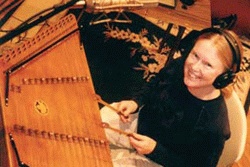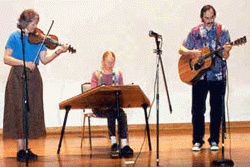I did not grow up a musician. Though raised in a family of nine kids in Connecticut, there was not a musician among us. Mom told me that there were musicians in her ancestry. However, I'd have to honestly say that in my immediate family, no one would consider themselves to be an even half-decent singer, and there were no musical instruments in the house. To my knowledge, no one had an interest in taking up an instrument, or perhaps doing so was not an affordable possibility for our big family.
Starting at a pretty young age, my interests and talent seemed focused on visual and fine arts; those were the classes I opted for in high school and college. This eventually led me to the profession which has best supported me financially -- that of a graphic artist. As a young adult, I also dabbled in ballet and modern dance for a time, but just as a hobby. During this phase of my life, I developed an appreciation for many types of music -- classical, jazz, folk, and especially Celtic influences. At this point, I still considered myself merely a listener and not a creator of music. But just as a very young child learns to speak by hearing the spoken word, I was tuning into the language of music as a young adult and planting the seeds of it in my soul.
 |
| Denise Martin in the recording studio with her hammered dulcimer. |
 |
How did I end up a folk musician in Anchorage, Alaska? I have one person to thank for leading me on this new path. That person is now my husband, Jim Kerr. We met while we were in our twenties, after I'd moved to Alaska in search of adventure. Though I hadn't a clue yet, I would in time find adventure through the folk music scene in Alaska. I marveled at Jim's mandolin-playing skills. Our mutual interest in folk and Celtic music was definitely part of what drew us together. He also introduced me to a number of folk musicians in Anchorage, and to the local square- and contra-dance scene. We were married in 1983.
One day, I picked up a penny whistle -- as simple an instrument as you can get in terms of maintenance and portability (you don't even have to tune it!). Plus, I'd heard and seen it used so often in the Irish tunes I was becoming very familiar with and sound of it. Jim encouraged me to keep playing around with it, and was surprised at how quickly I could figure out tunes, which had taken him much longer to master. Throughout my learning process, I discovered how the phrasing of most Irish tunes has a consistent pattern of repeats. This appealed to me aesthetically, like a symmetrical design -- it seemed logical. Perhaps this tradition of repeated sections came about because it allows for an easier way to memorize the tunes. All I know is that it worked for me.
Eventually, I had enough courage to play the penny whistle at some of the informal dances, but I usually wouldn't do it unless Jim came along. Plus, there were enough other musicians jamming along that I didn't have to worry if I made mistakes. Jim started getting really good at backup guitar, and it boosted my ego a lot when I really seemed to sound better with him playing along!
 |
| Denise Martin at the 2001 Alaska State Fair. |
 |
One musician who also inspired me was our friend Elsa Aegerter, who plays whistle and flute. I learned a lot from her about harmonies and arrangements. The three of us soon formed a little band, called Jubilee. We played for dances and festivals, and though we weren't in it for the money so much as the sheer joy of the music, sometimes we would get paid a little for our efforts. Fiddler Shonti Elder eventually joined, and the four of us played, performed, and expanded our repertoire to amazing heights after only a few years. Jim and I both dabbled with fiddle lessons from Shonti for a time, but it never quite stuck for either of us -- likewise with keyboard accordion, which I tried for a while.
The instrument that made the biggest impact on me was the hammered dulcimer. I first saw one at an Anchorage Renaissance Fair in 1982. Jerry Tande, from Eagle River, Alaska, was building and selling them at the Fair. Jim saw that I could pick out a simple tune on the thing, and he bought me one! I absolutely fell in love with it and played it all the time. When kids ask me today how I learned to play it, I tell them that I quit watching TV, which in a very real sense is true. Except for some pointers Jerry gave me when I started out, I am pretty nearly self-taught, just as I was on the penny whistle. Keeping it set up in the living room gave way to spontaneous practice whenever I had the chance. The hammered dulcimer, because of its uniqueness, brought a lot of attention to my performing, in addition to bringing new musical dimensions and popularity to Jubilee.
I took up the concertina after a few years of dulcimer playing. It was more of a challenge to learn, but I gradually introduced concertina tunes to the sound of Jubilee. Once again, Jim bought me this instrument as a gift, because he could tell that it seemed to click with me. Needless to say, playing music changed my life in a big way, just as getting married to Jim did. I gave up ballet dancing, but felt no loss as the joy of music really filled my days. We played for lots of dances and had a blast at jam sessions and festivals. We got hired to play all over Alaska and even in Canada. I'd call this the "party" phase of my life.
That era changed abruptly when our daughter, Amanda, was born in the summer of 1987. Gone for me were the late-night jam sessions and gigs requiring lots of travel. We learned this after a few challenges brought on by bringing a baby along to our gigs, especially the out-of-town ones. You can lay your kid down to sleep in a guitar case, but you can't close the lid when she starts crying. And yes, you do have to interrupt a tune sometimes for breast-feeding. In spite of the challenges of parenthood, Jim and I struggled to keep our music alive. When Amanda was about 2 years old, Jim and I did our first studio recording, an album of hammered dulcimer tunes with guitar backup entitled One Moment Forever.
 |
| Jubilee in performance: from left, Shonti Elder, Denise Martin and Jim Kerr. |
 |
As Amanda got older we slowly got back into the swing of things. In 1991 Jubilee recorded an album entitled
A Welcome Sound. This proved to be a much more difficult project. By then, the band members were starting families and getting serious about careers. It was hard to find the time to practice and record. Eventually, Jim and I produced another hammered dulcimer album in 1995 titled
Christmas in the Air. It was much easier to work with just the two of us with a daughter who was old enough to actually help in the process. She recorded a fiddle track for us at the age of 8, but we decided against using it because it was an album of hammered dulcimer music and fiddle did not really fit in the theme.
Amanda has grown up surrounded by music and musicians. She began fiddling at a very young age, and lives in a home filled with musical instruments. She's been blessed with exceptional Suzuki training from Beverly Beheim from the age of 4. Her Dad's encouragement and focus on early training has definitely been a major influence. Also, I've witnessed how Jim's driving backup guitar has given her the same inspiration it did for me, though her fiddling style is all her own and very different from my typical genre. Amanda has displayed remarkable musical talent, and motivation to excel in a way that transcends nearly every other aspect of her young life.




